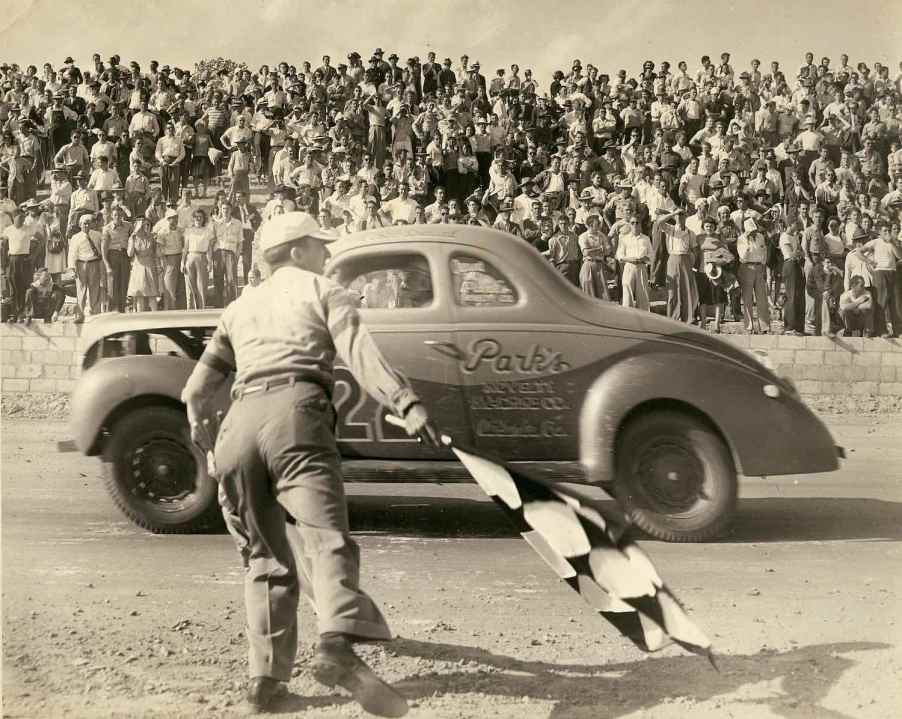
Does NASCAR Just Mean ‘Nice Car?’
I wasn’t into watching NASCAR racing for long before someone got me a birthday card titled “How the term ‘NASCAR’ was invented.” On the front, two men in overalls gawk at a sports car, saying, “Nas car, huh?” and “Yup. Real nas!” As amusing as the card is, the truth is that the NASCAR name is an acronym for the National Association for Stock Car Auto Racing, LLC. The name was suggested by a mechanic at a bar in Daytona Beach, Florida for an interesting reason.
Who founded NASCAR?
Retired driver Bill France is the founder of NASCAR. He called his first 40-race season (1947) the National Championship Stock Car Circuit (NCSCC). That winter, he brought together an eclectic group of almost 40 drivers, car owners, promoters, and mechanics to hash out a national racing league. They settled on the “National Association for Stock Car Auto Racing.” But not until after some debate over the NASCAR name.
When William “Big Bill” France arrived in Daytona Beach in 1935, prohibition had been over for two years. The South had many racing leagues where folks could watch stock cars hot-rodded up by bootleggers race one another. France entered the 1936 race right on Daytona Beach along with 27 other cars. All but 10 got stuck in the sand, and France finished fifth.
Though the events were popular, there was no unified organizing body. There was no standardized rule set for a National Championship. Worse yet, many race organizers promised prize money, then didn’t pay the drivers. After France ran a series of races in the South in 1947, he decided it was time to go national.
He invited organizers, drivers, and teams to the bar at the Streamline Hotel in his hometown of Daytona Beach. He tried to get the AAA to sponsor him, too. But for some reason, they didn’t show up.
Racers and stakeholders who had raced one another since the moonshine days, came together from as far away as New England. According to NASCAR, France said, “Stock-car racing has got distinct possibilities for Sunday shows, and we do not know how big it can be if it is handled properly…We are all interested in one thing – that is improving the present conditions. The answer lies in our group right here today to do it.”
How did NASCAR get its name?
The drivers and owners at the initial meetings had a lot to work out. But first, they had to vote on a name. It was mechanic, Red Vogt, who suggested the “National Association for Stock Car Auto Racing.” But that was far from the first suggestion.

France suggested the National Stock Car Racing Association (NSCRA). But remember, the country had a tangle of different governing bodies running local racing series. At the Streamline Hotel meeting, someone told France that a competing outfit was already called the National Stock Car Racing Association.
Driver Robert “Red” Byron was at the meeting with his team, including his mechanic who was, confusingly, also nicknamed Red (Louis Jerome “Red” Vogt). Red Vogt pointed out that if they swapped the letters around, their acronym would end in “CAR” and be easier to remember. The resulting name was the National Association for Stock Car Auto Racing: NASCAR.
Red and Red were apparently as good with cars as they were with acronyms. Their team won the Association’s inaugural season in 1949.
How did NASCAR start?
After organizing one racing season on his own, NASCAR founder Bill France enlisted an Association of drivers, mechanics, race promoters, and team owners to form and name NASCAR. He insisted they establish a nationwide set of rules, a way to name a national champion, and a clear cash-paying points system that paid teams well.

The Association’s first race was on the sand at Daytona Beach and won by Red Byron. The Association then kicked off its first “strictly stock” race series at the Charlotte Fairgrounds Speedway. The series wrapped up in October, and though multiple drivers won races, Red took home the first Championship.
Big Bill France Sr. continued to chair NASCAR until he handed the reins to his son, Junior, in 1972.
Next, learn the history of NASCAR’s fastest track, or see the history of the entire sport in the video below:






